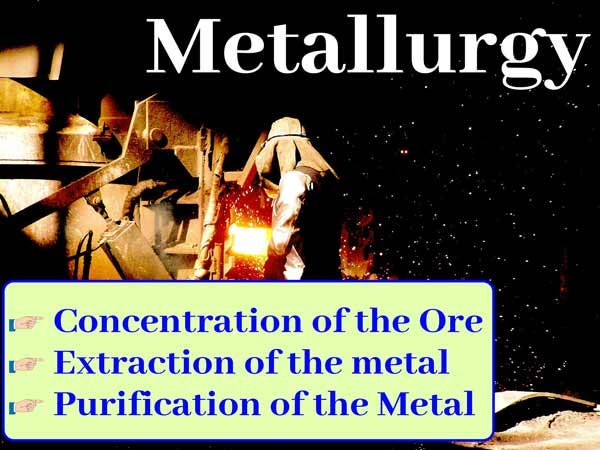Metallurgy Process | Definition with Exampls
Some physical and chemical processes are used to obtain pure metals from the ore. The process of obtaining pure metal using physical and chemical processes from ore is called metallurgy.
The following processes are used in metallurgy.
- Concentration of the Ore
- Extraction of the metal
- Purification of the Metal

Concentration of the Ore
The ores are extracted from the mines and there are pieces of stone, pebbles, pebbles, sand, and stones of pollutants. These residues are called gangue or matrix. The process of separating gangues present in ores obtained from mines is called concentrating of ore.
To concentrate the ore, firstly by separating large pieces of ore by hand. After this, they are broken into small pieces by handcuffs. These small pieces are put in the crushers. The crushers are like a millstone. Which consists of two plates.
One plate runs and the other plate stays level. The crushers crumble small pieces. The small pieces obtained in this way puts pieces in stamp mill. Where there are frequent hammer injuries on them. This process grinds ore into a very fine form.
Several methods can be used after grinding large pieces of ore to concentrate the ore. Depending on the nature of the ore and the gangue, one or more of these methods is sometimes used. Some of the following are the major methods.
Froth Flotation Method
This method mainly concentrates sulfide ores. When sulfide ores are added to the oil and water mixture. Sulfide ores are then drenched by oil faster than impurities present in them and impurities present in sulfide ores are drenched by water faster than sulfide ores. This method is very common in Metallurgy.
In this way, when the air flows in suspension of sulfide ore made in oil and water, the particles of sulfide ore become foamy and come to the upper surface and the impurities settle down. This method is also called froth buoyancy method.
In this method, sulfide ore is grinded very finely and put in a pond filled with water. It contains small amounts of pine oil, turpentine oil, eucalyptus oil, or sodium xanthate oil to flow a strong stream of air and the oil-soaked sulphide ores get deposited as foam.
And other impurities present in the ore, such as soil, are deposited on the bottom of the pond. Concentrated ore is thus obtained.

Extraction of the Metal
The complete process of obtaining metal from concentrated ore is called extraction of metal. Depending on the nature of the ore and the method used for extraction of the metal, several terms are used in this process. Following are some of the key terms commonly used in metal extraction.
Calcination
In the process of Calcination, the concentrated ore is heated
enough that volatile metals are released from it. But the ore is not allowed to
melt. Carbonate oxidase and hydroxide ores are usually disposed of.
Example: The water present in Al2O3 is evaporated and released.
Al2O3.2H2O → Al2O3 + 2H2O
Example: The water present in Fe2O3 is evaporated and released.
Fe2O3.3H2O → Fe2O3 + 3H2O
Purification of the Metal
The metal obtained from the extraction of the metal from the ore is often impure. It often contains impurities of carbon silicon phosphorus etc.
The method of refining of any metal depends on its nature and the nature of impurities present in it. Therefore, different types of methods are used for this. Electrolytic method is main in this. Very pure metal is obtained in this method.

The electrolytic method of refining metals can be explained by the example of refining of copper metal by this method. For the refining of copper metal, electrolyte solution of copper metal salts in electrolytic cell acts as an electrolyte, thick plates of impure metal act as anode and thin plates of pure metal act as cathode.
When electrolysed in an acidic solution of copper sulphate, thick plates of impure copper metal at the anode begin to dissolve and impurities accumulate down the solution. These impurities are called anode mud. Cu forms its cations that move into the solution.
